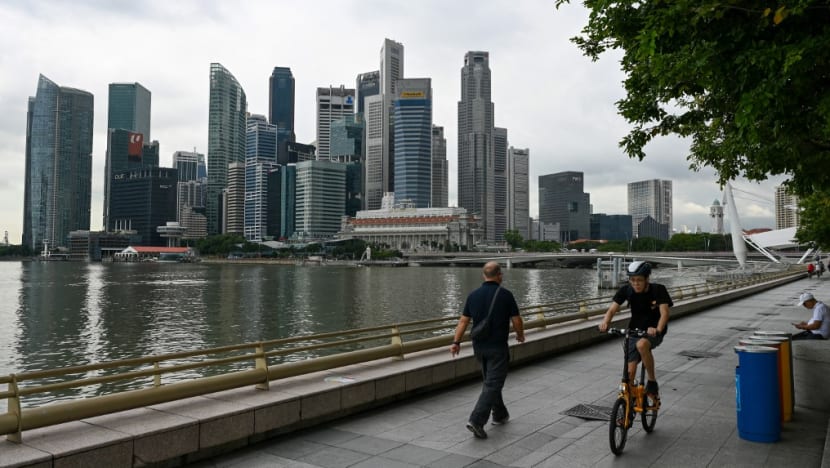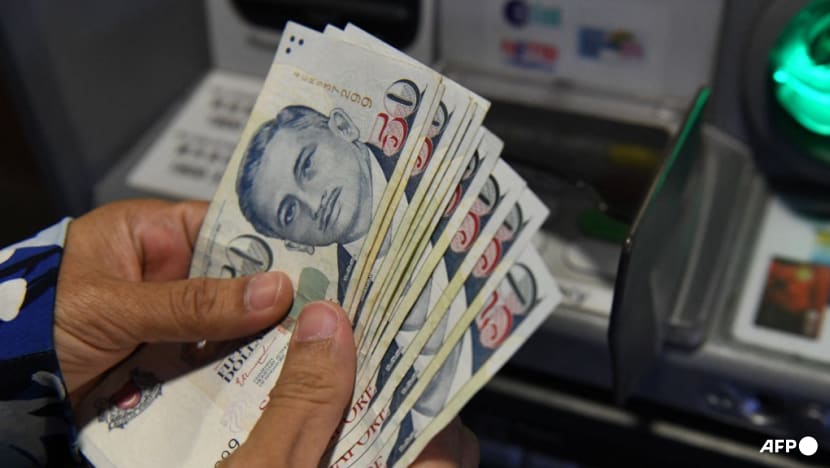Commentary: More uncertainty for Singapore economy after US interest rates cut
Lower domestic interest rates should go some way to ease financial strains for companies and households, but these are still uncertain times, says Coface chief APAC economist Bernard Aw.

A general view shows the financial business district in Singapore on Jan 3, 2022. (Photo: AFP/Roslan Rahman)

This audio is generated by an AI tool.
SINGAPORE: Local interest rates have fallen by about 50 per cent since 2024. The three-month compounded Singapore Overnight Rate Average (SORA) – often used as a benchmark for residential mortgages and other medium-term loans – dropped to as low as 1.44 per cent this year.
Singapore’s approach to monetary policy means it is an interest rate-taker – domestic interest rates generally track global interest rates, especially the United States’. So when the US Federal Reserve announced its first interest rate cut in 2025 on Sep 17, many here paid attention to it.
The US central bank took this action to address concerns about slowing job growth and also projected two more successive reductions by the end of the year.
Could Singapore see a further drop in domestic interest rates?
WILL SINGAPORE INTEREST RATES FALL FURTHER?
In Singapore, SORA tends to track the US Federal Funds rate closely, but local rates have diverged significantly from US rates since the start of the year.
The latest Fed decision puts the US policy rate at 4 per cent to 4.25 per cent, which would be commensurate with SORA at 3 per cent. But SORA is currently around half that level. Could there be other reasons for the notably lower local rates?
For one, Singapore’s financial markets have attracted a surge of capital inflows this year. Net fund flows into the country increased by 125 per cent in the first half of 2025 compared to the same period last year, reaching S$6.3 billion (US$4.9 billion), according to data from the Investment Management Association of Singapore. The Singapore dollar strengthened nearly 5 per cent against the US dollar by September.
Global investors’ desire to mitigate risks related to geopolitics and global trade led them to look to a “safe haven” market like Singapore.
Singapore equities delivered a total return of 24 per cent since the start of 2025, double the MSCI All Country World Index’s 12 per cent gain. The MAS’ Equity Market Development Programme (EQDP) initiative has also spurred interest in Singapore equities. This contributed to abundant domestic liquidity, which is pushing local interest rates down.
But with the US central bank rate cut projections in the next several years fairly shallow, it may be difficult for SORA to fall further.
WHAT IT MEANS FOR SINGAPORE HOUSEHOLDS AND BUSINESSES
Still, the lower interest rate environment is a welcome change, even if it’s not back to the era of “easy money”, which ended in 2022 when central banks aggressively raised rates to fight high inflation. Loans to consumers, which include mortgages, and to businesses have accelerated in recent months.
For Singapore households, lower interest rates mean the burden of servicing existing debt is easing. Fixed rate mortgage packages offered by banks peaked at 4.5 per cent in end-2022 and have fallen below 2.5 per cent in the first half of 2025.
As mortgage repayments shrink, especially for those with floating loans, home owners will effectively have more money to spend on goods and services, especially with inflation easing. Lower domestic interest rates also support asset prices (such as housing and equities), increasing households’ wealth, which can lead to higher consumption.
There are fewer incentives to save money, especially when local banks like UOB and OCBC have cut rates on their flagship accounts this year. But some savers, particularly retirees, may choose to restrict their spending if they get less income from deposits.

For local businesses, the lower cost of borrowing will encourage them to take up new loans, especially for exporting businesses. Lending to trade-related sectors, such as manufacturing, wholesale and retail trade, and transport and storage picked up notably in 2025, supported by buyers abroad front-loading their purchases ahead of US tariffs.
Lower interest rates will also likely provide relief for the construction sector as it relies on commercial bank loans to finance its operations. Construction firms have already been trending towards a lower risk of defaulting on repayments, though it is still high compared to all commercial bank loans. Higher labour and material costs continue to impact profitability and cash flows.
Small- and medium-sized enterprises (SMEs) may not immediately benefit from lower market interest rates as SME lending rates are typically less responsive, especially if the SME loan applicant lacks collateral and credit information.
SLOWER GROWTH AHEAD
Despite these positive economic signals, the overall outlook remains uncertain. Companies’ ability to plan and invest requires predictability, but all signs suggest US President Donald Trump is not done with his tariffs, after a string of sector-specific tariffs that have been announced or suspended on short notice.
Singapore will be more greatly affected by these external developments rather than domestic consumption, especially if growth among key trading partners such as China and the US slows.
Economic data shows China is still in deflation, while inflation in the US has started trending up again. There were concerns about whether the Fed made the right move at a tricky time when the US job market is weak and inflation has been sticky. US analysts are even forecasting that the US economy might be headed for stagflation.
Therefore, Singapore’s economy should continue to expand but at a slower growth momentum.
In an increasingly challenging economic environment, Singapore has stepped up efforts to support the economy. In February, the government permanently doubled the maximum loan quantum for Enterprise Financing Scheme – Trade Loans (EFS-TL), a trade financing loan for businesses, from S$5 million to S$10 million. In July, the Singapore Economic Resilience Taskforce announced the Business Adaptation Grant, available from October, to help companies defray costs associated with overseas expansion and advisory services.
The Monetary Authority of Singapore (MAS) has allowed the Singapore dollar to appreciate more slowly, reducing the slope of its S$NEER policy band twice, in January and April, and maintaining it in July. But there is no urgency to ease monetary policy further as financial conditions are already easing with local rates falling rapidly.
Lower domestic interest rates should go some way to ease financial strains for companies and households, and a relatively strong Singapore dollar could contain consumer price pressures.
Nevertheless, there is significant uncertainty towards Singapore’s economic prospects, especially in 2026. All eyes will be on global trade developments and changes in tariff rates worldwide, particularly on sector-specific duties.
Bernard Aw is Chief Economist for Asia Pacific at Coface.



















